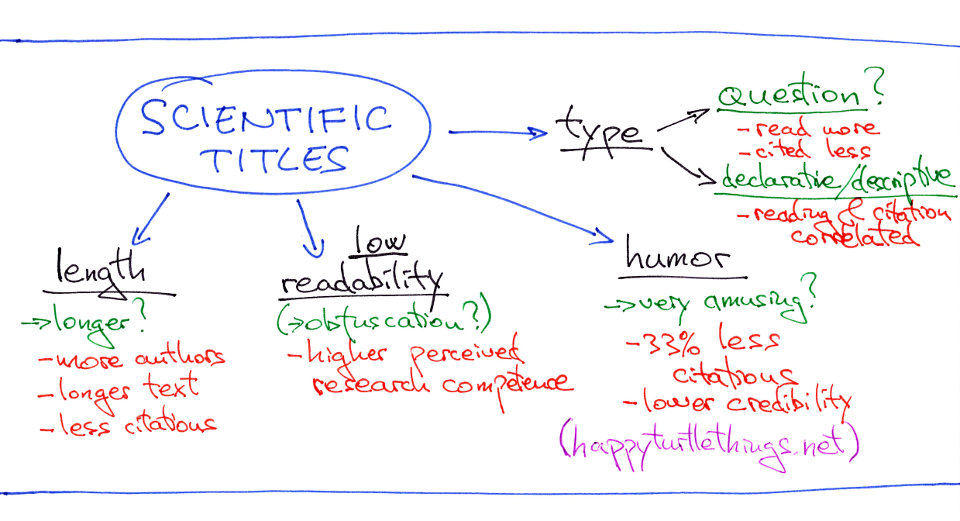The debate on the business of citation accumulation in scientific publishing is long and deep-rooted, but the science of citation accumulation — not so much. In this little post, I'm summarizing some of the interesting research done on the effect that titles have on the number of citations a scientific piece of text receives. This might be a good place to start the next time you're sending off your literary work of art into the world.

Title type
An analysis (Article title type and its relation with the number of downloads and citations; H. R. Jamali, 2011) that looked into the effect of the type of article title on the likelihood of the article being cited divided them into three main types: interrogative (i.e. containing a question), descriptive or neutral, and declarative (the title contains the main conclusion of the article).
They looked at all of the papers published in 2007 in six biomedical journals and found that the marketing of interrogative titles works! On average, the titles containing a question proved to be downloaded about twice as more than those that didn't. Before you start planning your next research question, let me bring you down by telling you that they were cited over a third less times than those titles that didn't contain a question.
The declarative and descriptive titles didn't show much difference in the number of downloads and citations – and naturally, the number of citations was positively correlated with the number of downloads of these articles. It appears as if the contents are what matters more than a marketing gimmick cleverly positioned in the title.
Title lenght
This one's easy. Articles with shorter titles receive more citations, on average. The paper (aptly?) titled The advantage of short paper titles (A. Letchford, H. S. Moat, T. Preis, 2015) presents an investigation into the number of citations received by journals that publish papers of a certain length – and shows that those characterized by shorter titles tend to receive more citations than the rest.
Additionally, the papers that are presented with longer titles have been shown to, on average, have more authors (Relation of title length of journal articles to number of authors; M. Yitzhaki, 1994) – more commonly found in journals specializing in harder science, as opposed to those in social science. A suggestion as to why this might be the case goes along the lines of the presence of keywords in titles; having more authors with different backgrounds will likely lead to more keywords having to be included in the title.
In the same tune, there exists a Relation of the title length of a journal article to the length of the article (M. Yitzhaki, 2002). Articles with titles that contain more significant words are found to have more pages, which means that there exists a greater chance of them containing useful information for more people. Somehow, looking at the citations they receive, that doesn't seem to be the case.
Readability
The chief goal of publishing a scientific text should be its clear communication to a scientific community or the general public. Sadly, that's not how the cards are stacked up for us.
A modest overview of this (one that I wholeheartedly recommend) can be found in the paper on Creative Obfuscation (J. S. Armstrong, 1982), where the old adage "If you can't convince them, confuse them." rings much more true than it should. Low clarity is related to an impression of higher prestige and research competence of the author of the scientific article. If you think this is too depressing, scroll down to the end of this post for a report on an exciting field experiment from 1973 that tested obfuscation as a method for influential scientific communication in the form of lecture talks. It should not make you feel better, but your cynicism might level up.
For an interesting view on the claim presented above, you can check out this paper on the Vagueness, Ambiguity, and the Cost of Mutual Understanding (I. Erev, T. S. Wallsten, M. M. Neal, 1991), where an experiment is used to show that the frequency of vague communication increases in a controlled setting when it is beneficial for the group. Communication that may be interpreted in many ways is likely to be interpreted such that the majority of the recipients will agree with the presented statement, facilitating the approval of a greater number of people. Obfuscation may work in a similar fashion.
Humor
If you're like me, you enjoy a good joke or a bad innuendo in a title of a research paper – you will be more likely to open and read it, and willing to consider that it might contain amusing, if not always useful information. That's all fun and games, but when you're publishing your own, don't make it very funny.
The study on the Amusing titles in scientific journals
and article citation (I. Sagi, E. Yechiam, 2007) had volunteer graduate students (not very many of them, though!) scroll through a decade's worth (about a thousand) of psychology papers from two major journals in behavioral science, and rate them for their pleasantness and amusement. Pleasantness here referred to "giving the sense of happy satisfaction or enjoyment," and amusement, or humor "the quality of being amusing or comic." The results were defeating: those papers that were rated as more than two standard deviations more amusing that average (highly amusing) were found to be cited approximately 33% less than those that scored low on the amusement scale. To bring the point home, they managed to analyze the number of citations received by about a dozen pairs of titles in the bunch that were written by the same author, published in the same journal, and scored high and low in amusement, respectably. The result was fascinating – they found a 62% difference in the number of citations, an effect much greater than the one found in the pool of all published articles. However, this may be because of the small sample used.
In case you're wondering about other research into the effect of humor on the communication in a scientific setting, look no further; these three studies should cover the basic questions:
- Effects of humorous illustrations in college textbooks
- Relationship between Humor in Introductory Textbooks and Students' Evaluations of the Texts' Appeal and Effectiveness
- Enhancing online instruction with humor
They all present conclusions implying that the inclusion of humor in textbooks and during instruction leads to the increased enjoyment, participation, and appeal of the material, but causes a stark drop in the persuasibility of the material and the author's credibility. Sad news, but at least you can rely on my posts to keep you entertained.
Bonus field study on obfuscation
Now for the fun part; The Doctor Fox Lecture: A Paradigm of Educational Seduction (D. H. Naftulin, J. E. Ware, F. A. Donnelly, 1973):
Given a sufficiently impressive lecture paradigm, an experienced group of educators participating in a new learning situation can feel satisfied that they have learned despite irrelevant, conflicting, and meaningless content conveyed by the lecturer.
The authors chose an actor who looked distinguished and sounded authoritative, called him Dr. Fox and had him present several lectures on the Mathematical Game Theory as Applied to Physician Education, helped exclusively by the use of double talk, neologisms, non sequiturs, and contradictory statements.
The results were beautiful.
Most of his audience agreed that he gave a well organized lecture, provided enough examples to clarify his statements, stimulated their thinking, and presented the material in a very interesting fashion.
People are sheep and science is basically marketing.

